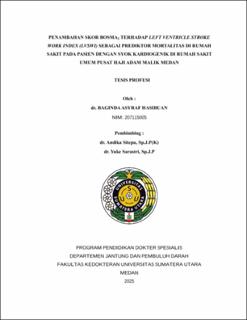Penambahan Skor Bosma2 terhadap Left Ventricle Stroke Work Index (LVSWI) sebagai Prediktor Mortalitas di Rumah Sakit pada Pasien dengan Syok Kardiogenik di Rumah Sakit Umum Pusat Haji Adam Malik Medan
The Integration of the BOSMA2 Score to Left Ventricular Stroke Work Index as a Predictor of In-Hospital Mortality in Patients with Cardiogenic Shock

Date
2025Author
Hasibuan, Baginda Asyraf
Advisor(s)
Sitepu, Andika
Sarastri, Yuke
Metadata
Show full item recordAbstract
Background: Cardiogenic shock is a life-threatening condition characterized by the heart's inability to pump sufficient blood to meet the body's metabolic needs. The Left Ventricular Stroke Work Index (LVSWI) is a hemodynamic parameter used to assess left ventricular function, but its sensitivity in predicting mortality remains suboptimal. The BOSMA2 risk score integrates multiple clinical parameters and may enhance mortality prediction. The aim of this study is to evaluate the predictive value of BOSMA2 score in combination with LVSWI in assessing in-hospital mortality risk among cardiogenic shock patients.
Methods: This retrospective cohort study analyzed data from cardiogenic shock patients treated at Haji Adam Malik General Hospital in Medan, Indonesia. Participants were divided into two groups: mortality and non-mortality group. Clinical characteristics, echocardiographic, and laboratory data were collected. Statistical analysis included ROC curve analysis to determine the predictive accuracy of LVSWI, BOSMA2, and their combination.
Results: A total of 180 patients were included, with a median age of 61 years and a male predominance (71.1%). Primary diagnoses included acute coronary syndrome (69.4%) and heart failure (83.3%). The study comprised 121 patients in the mortality group and 59 in the non-mortality group. In the mortality group, the median BOSMA2 and LVSWI scores were 5 (1–6) and 11.45 (4.71–23.37), respectively; while in the non-mortality group, the scores were 2 (0–4) and 13.86 (3.50–34.26), respectively. The mortality group had significantly higher BOSMA2 scores (p <0.001) and lower LVSWI values (p <0.001). ROC analysis demonstrated that the combination of BOSMA2 and LVSWI had superior predictive value (AUC = 0.994) compared to LVSWI alone (AUC = 0.677) or BOSMA2 alone (AUC = 0.992).
Conclusion: The integration of the BOSMA2 score with LVSWI enhances in-hospital mortality prediction in patients with cardiogenic shock, although it does not significantly differ from the prediction of mortality using the BOSMA2 score alone.
Collections
- Master Theses [107]
